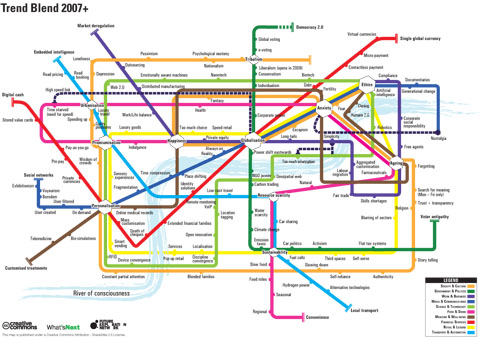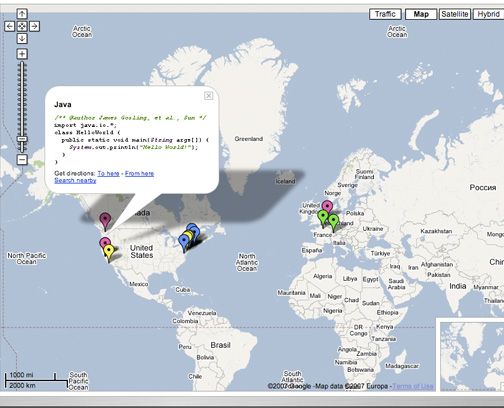
Author: Martien van Steenbergen
Martien is a Visioneer and touched by software.
people | software | happiness™
Ode ziet het Wiki-licht:
:Van de andersglobalisten tot de Wikipedianen: zelforganisatie is het sleutelwoord. Niet doen wat je wordt opgedragen, maar doen wat je kan en wil bijdragen – voor een groter geheel. Marco Visscher beschrijft de opkomende participerende cultuur.
[http://aloha.aardrock.com Aloha] is op de goede weg met haar Wiki voor het schrijven van een schitterend boek.

Amy Tenderich writes about iPod design for diabetes care:
:Why, oh why, do consumers everywhere get the most “insanely great” little MP3 player, while we whose lives depend on medical devices get the clunky stuff of yesteryear?
”’Excellent idea Amy!”’ Sure hope that Steve bites. And while at it, diabetes software can use an upgrade as well.
Reminds me of ”’Cheetah”’: First half of 2006 a small team of students have been working on Cheetah—a fully distributed self-learning (smart) peer-to-peer community-based diabetes open source software system.
Oh, how nice it would be for my daughter with diabetes to have the two “marry”.
See:
http://wiki.aardrock.com/Cheetah_Project_Proposal
http://wiki.aardrock.com/Cheetah_Work_Space
Trend Blend 2007 kaart
Information Ecology
In the same issue of the Automatiseringgids there is an interesting article on [http://en.wikipedia.org/wiki/Information_ecology Information Ecology]—the evolotionary aspects of self-organizing information. Wikipedia alo links it to the [http://en.wikipedia.org/wiki/Noosphere noosphere].
Article in Automatiseringgids on [http://www.cs.cmu.edu/~biglou/ Luis von Ahn]’s [http://www.espgame.org/ ESP Game]—a.k.a. the [http://images.google.com/imagelabeler/ Google Image Labeler]—to smart tag images by human swarms.
Ahn also created the spam-avoiding [http://www.captcha.net/news/ai.html Captcha].
Thank you very much Luis!
Microsoft, Google and Yahoo! Now Support GeoRSS: “Lord Satri writes ‘This week, Microsoft announced their new Live Maps, in addition to supporting Firefox on Windows for 3D, now supports the GeoRSS standard. They join Google which recently announced the support of GeoRSS and KML mapping in their Google Maps API.
In short, GeoRSS is a standard supported by the Open Geospatial Consortium that incorporates ”’geolocation in an interoperable manner to RSS feeds”’. The applications are numerous. With Yahoo!’s support of GeoRSS, all the major players are in and the future looks bright for this emerging standard.
As for KML, Google Earth’s file format, this new Google Maps integration is not unrelated to the recent announcement of internet-wide KML search capabilities within Google Earth.
From the GeoRSS website: ‘As RSS becomes more and more prevalent as a way to publish and share information, it becomes increasingly important that location is described in an interoperable manner so that applications can request, aggregate, share and map geographically tagged feeds. To ”’avoid the fragmentation of language”’ that has occurred in RSS and other Web information encoding efforts, we have created this site to promote a relatively small number of encodings that meet the needs of a wide range of communities.’
(Via Slashdot.)
What’s next: PeopleRSS—a standard that incorporates personal information as well as group, team, department, company information. Or communities in general, a singel perseon being the smallest community. Add a touch of ProjectRSS and EventRSS and voilà, peer-to-peer fully distributed open mirrorworlds.
As a member of the Identity Commons mailing list for several years now I find many of the organizational conversations very interesting. Especially the dialogs on principles, articles, bylaws, organization, etc.
I feel compelled to contribute in some way, but force myself not to for the simple reason that I know that I cannot sustain the level of contribution that the IC needs. And I must set and keep these expectations right in order not to disappoint either of us. Please forgive me for that.
Anyway, Eugene’s (again excellent) summary on last week’s (3/28/2007) call mentioned the subject of voting again. This triggered me to send them this article on Holacracy from Drian J. Robertson from the Cutter Consortium. You probably already know about it, but I just want to make sure you wouldn’t miss it.
Please allow me to quote from page 12:
:”’On votes”’
:Another common question is about the “possible votes” in integrative decision making. At first it can sound like there are two possible votes on a proposed decision—”consent” or “object”—though that’s missing a key point. ”’Consent isn’t about “votes”at all”’; the idea of a vote doesn’t make sense in the context of consent. ”’There are no votes, and people do not vote.”’
: People do say whether they know of ”’a reason why the proposed decision is outside the limits of tolerance of any aspect of the system”’, and then decision making continues to ”’integrate that new information”’. This isn’t the same as most consensus-based processes—either in theory or in practice—although it does sound similar at first, especially before an actual meeting that seeks consent is witnessed.
Thoughts?
Twitterific
![]()
Twitterrific is a fun little application that lets you both read and publish posts or “tweets” to the Twitter community website. The application’s user interface is clean, concise and designed to take up a minimum of real estate on your Mac’s desktop.
The World of Hello World
A map of programming languages and rough locations in the world where they were created. Colors correspond to four major epochs: blue—first languages, green—establishing paradigms, yellow—consolidation and modules, pink—the Internet age.
Sun font by Lucas de Groot
While on the topic of fonts, the [http://www.lucasfonts.com/lucasfnt/sun/sun-.html Sun font] is my standard and favorite, as you can [http://aardrock.com see on AardRock’s home page]. The Sun font is designed by [http://www.lucasfonts.com/ Lucas de Groot] from [http://www.fontfabrik.com/ FontFabrik]. Even [http://en.wikipedia.org/wiki/Lucas_de_Groot Wikipedia has a page on Lucas de Groot].
I’ve got something with fonts. Especially sans fonts. A couple of months ago, I got a small booklet handed out by Premsela titled “[http://www.morf.nl/inhoud/morf_nr4/artikelen/index/-/nl Morf 4]”. Martin Majoor writes about the correct use of typography in is article [http://www.morf.nl/inhoud/morf_nr4/artikelen/04_06_majoor/-/en Did the French king have shoe size 49?]. Nice and clean piece of work on emdashes, endashes, single qoutes and apostrophes among other things.
Can’t find a home page on Majoor or any other good source to contact him. Any help is appreciated.
”’Eindelijk!”’ [http://gallery.jobemedia.org/map_about.html Klein Duimpje] voor je foto’s en de plek waar je ze genomen hebt. Google Maps + foto + GPS = reisverslag.
Tim O’Reilly’s [http://blogs.oreillynet.com/mt/mt-tb.cgi/1920 Call for a Blogger’s Code of Conduct] heeft een paar rake punten:
#Neem verantwoordelijkheid, niet alleen voor je eigen woorden, maar ook voor de commentaren die je toestaat op je blog.
#Label je tolerantie voor offensieve en beledigend commentaar.
#Overweeg anoniem commentaar te elimineren.
#Negeer de trollen.
#Zet het gesprek offline voort en spreek openhartig of vind een intermediair die dat kan en wil.
#Zeg het degeen van wie je zijn of haar gedrag afkeurt.
#Zeg online niets wat je in persoon ook niet zou zeggen.

